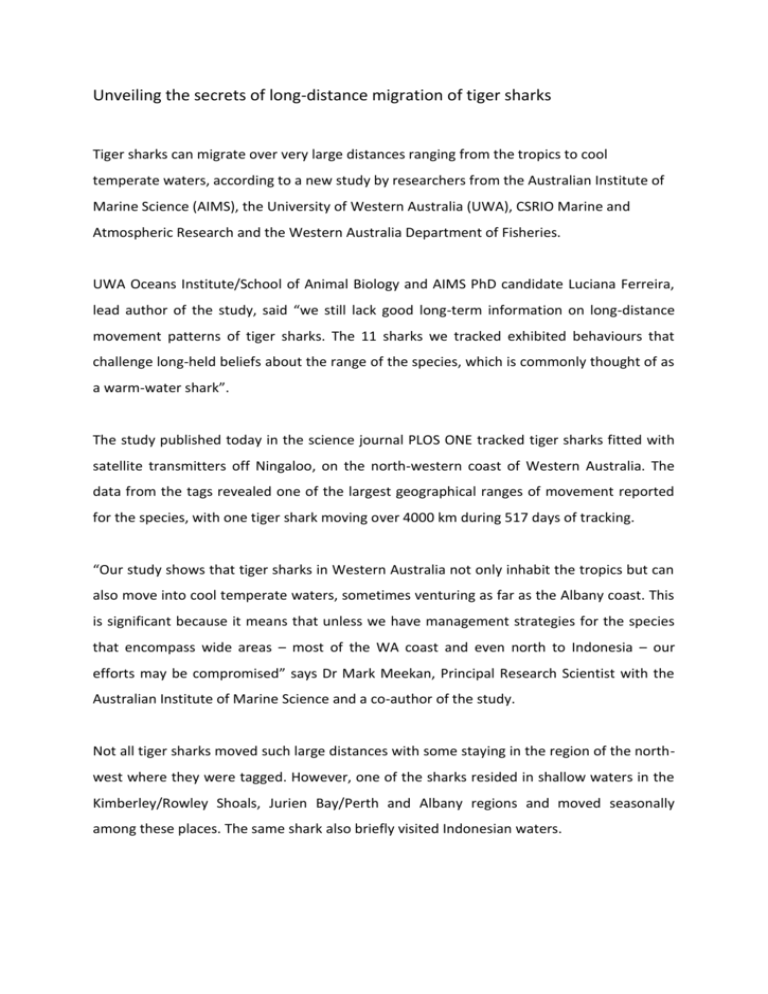Media Release
advertisement

Unveiling the secrets of long-distance migration of tiger sharks Tiger sharks can migrate over very large distances ranging from the tropics to cool temperate waters, according to a new study by researchers from the Australian Institute of Marine Science (AIMS), the University of Western Australia (UWA), CSRIO Marine and Atmospheric Research and the Western Australia Department of Fisheries. UWA Oceans Institute/School of Animal Biology and AIMS PhD candidate Luciana Ferreira, lead author of the study, said “we still lack good long-term information on long-distance movement patterns of tiger sharks. The 11 sharks we tracked exhibited behaviours that challenge long-held beliefs about the range of the species, which is commonly thought of as a warm-water shark”. The study published today in the science journal PLOS ONE tracked tiger sharks fitted with satellite transmitters off Ningaloo, on the north-western coast of Western Australia. The data from the tags revealed one of the largest geographical ranges of movement reported for the species, with one tiger shark moving over 4000 km during 517 days of tracking. “Our study shows that tiger sharks in Western Australia not only inhabit the tropics but can also move into cool temperate waters, sometimes venturing as far as the Albany coast. This is significant because it means that unless we have management strategies for the species that encompass wide areas – most of the WA coast and even north to Indonesia – our efforts may be compromised” says Dr Mark Meekan, Principal Research Scientist with the Australian Institute of Marine Science and a co-author of the study. Not all tiger sharks moved such large distances with some staying in the region of the northwest where they were tagged. However, one of the sharks resided in shallow waters in the Kimberley/Rowley Shoals, Jurien Bay/Perth and Albany regions and moved seasonally among these places. The same shark also briefly visited Indonesian waters. “At least some tiger sharks appear to be making directed and seasonal migrations and crossing large areas of open ocean. Our results are important because describing these behaviours shows that these sharks, which are apex predators, are likely to be an important structuring force within ecosystems along the entire coastline of WA” Ms Ferreira said. Dr Meekan adds: “Our results show that regional marine protected areas are offering some protection for tiger sharks but the ability of these animals to travel long distances will mean that they move across management zones and national boundaries.” Ms Ferreira also said the study also showed that tiger sharks may be adapting their diving behaviour to the water temperatures, staying closer to the surface in cooler, more southern latitudes but diving deeper in tropical latitudes. This project was supported by AIMS, CSIRO, the WA Department of Fisheries, and UWA. The authors acknowledge the Conselho Nacional de Desenvolvimento Científico e Tecnológico (Brazil). For more information please contact: Dr Mark Meekan, Australian Institute of Marine Science (AIMS), m.meekan@aims.gov.au, +61(08) 63694039, +61 (0) 429101812 (mobile). Article title: Crossing latitudes – long-distance tracking of an apex predator Weblink: http://dx.plos.org/10.1371/journal.pone.0116916











